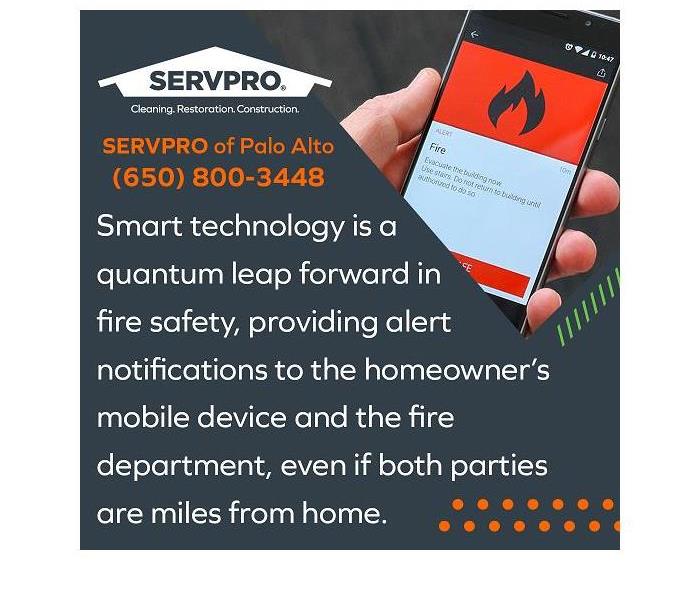How Smart Technology Can Prevent a Fire Damage Disaster in the Home
9/6/2022 (Permalink)
Blog Summary: SERVPRO of Palo Alto looks at the power of smart technology to prevent fire damage to homes in the Bay Area.
With the advent of the internet, an array of complementary smart devices have been developed to both detect and prevent fire damage in the home. Smart technology is a quantum leap forward in fire safety, providing alert notifications to the homeowner’s mobile device and the fire department, even if both parties are miles from home.
Smart Technology: Smoke Detection
Typical smoke detectors are only effective if heard by occupants in the home. Smart smoke detectors are connected to other devices such as a smartphone through the internet and can deliver alarm notifications to that smartphone or other devices in the network. Smart smoke detectors can also be connected into the home security system; this integration allows the smoke detector to be monitored by a central command and control station. Should the smoke detector activate, both the homeowner with a smartphone and the fire department are alerted to the presence of smoke in the home.
Upon detecting smoke particles, smart smoke detectors can be programmed to turn off the HVAC system. This deactivation of the air handling system can prevent or reduce the disbursement of smoke while occupants safely make their way out of the home. Some security systems have the capability to turn on lights and provide audible instructions about what to do in the event of a house fire.
Options for the tech-savvy homeowner do not stop here. A camera can be integrated with each smart smoke detector. In recent years, the price of cameras has come way down, and the functionality and quality of the devices have reached new heights.
If a smart smoke detector activates, so do one or more cameras, enabling the homeowner to record the alert event. This information can provide an understanding of the location of the smoke and the cause of the fire. Some integrations allow for real-time witnessing of the events as they unfold.
Other failsafe options include smart detectors sending an alert to a smartphone to notify the homeowner that the batteries need to be replaced. This safety feature is vastly superior to the annoying chirp of the low-battery warning of traditional smoke detectors. More advanced smart smoke detectors also can perform double duty as a carbon monoxide (CO) detector.
Smart Technology: Fire Detection
A heat detector adds another layer of fire protection. One type of heat detector operates at a fixed temperature. When temperatures around the device rise above the preset temperature, the alarm activates. Another type of fire detector activates when a rapid rise in temperature is detected. Often a device will have both features. Fire detectors are not a substitute for smoke detectors. They complement smoke detectors, which are the first line of defense against a fire. When these systems are interconnected, the activation of one alarm also activates other devices, resulting in a unified, seamless alert to occupants in the home to devices of family members not at home, to the security system, and to first responders.
Other Smart Devices to Consider for Home Fire Protection
A smart battery provides an alternative to purchasing a host of new fire and CO safety devices. The battery powers existing detectors while providing alarm notifications on connected smartphones. The battery also sends an electronic signal indicating that the detector’s battery power is waning. Motion sensing technology has been harnessed as an excellent fire prevention strategy in the kitchen, where unattended cooking fires are the top cause of fires in homes. If no motion is detected by the sensor after a predetermined time, a process is set in motion to shut off the stove. Smart outlets allow a homeowner to use a smartphone app to turn small appliances and lights on and off remotely.
Installation of these smart devices may require professional technical assistance if the systems are complicated, and the learning curve to gain proficiency with the systems may require time and effort. However, systems are becoming more and more user-friendly, more affordable, and more effective at alerting occupants and first responders to a fire.
By taking a smart approach to fire safety, the homeowner can significantly reduce the risk of a fire hazard. The purpose of smart technology is to alert occupants in the home and first responders to signs of smoke, fire, and CO so that a safe, fast evacuation can be implemented. Fire damage may be extensive, but no lives are lost.
In case of a property damage disaster, including a fire damage disaster, SERVPRO of Palo Alto is available 24 hours a day, 365 days a year, to help regain control of the situation quickly and begin the fire damage restoration process. A rapid response minimizes the disruption and reduces the cost of the overall project.
Contact SERVPRO of Palo Alto to learn more about fire damage restoration in Redwood City, CA. The office can be reached by phone at (650) 800-3448 or by emailing office@SERVPROpaloalto.com.



 24/7 Emergency Service
24/7 Emergency Service
